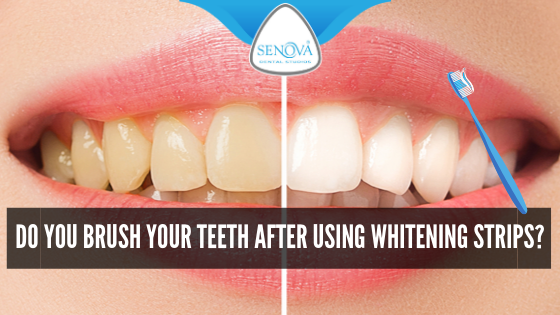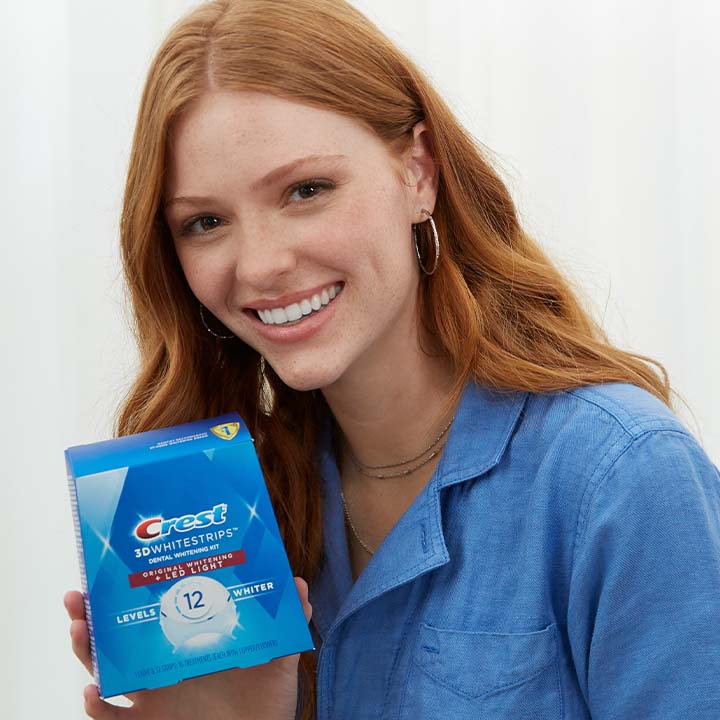Use Teeth Whitening Strips, but avoid exceeding the recommended usage to prevent enamel damage. Proper usage is vital for maintaining oral health and achieving desired results.
Teeth whitening strips have become famous for those seeking a brighter smile without the cost and hassle of professional treatments. However, it’s critical to understand the proper frequency of use to prevent any potential side effects. If not done correctly, daily use of whitening strips can lead to enamel erosion and tooth sensitivity.
Understanding the recommended frequency and following the instructions provided by the product can help you achieve a healthy and radiant smile. Remember, consistency and moderation are essential when using teeth whitening strips effectively.

Credit: www.senovadental.com
Teeth Whitening Strips
To achieve the best results, using teeth whitening strips daily and following the instructions provided are essential. However, excessive and prolonged use can lead to enamel erosion and sensitivity, so it is not recommended to use them daily.
What Are Teeth Whitening Strips?
Teeth whitening strips are thin, flexible strips coated with a whitening gel containing peroxide. These strips are designed to be placed over the teeth to improve their appearance by removing stains and discoloration. They offer a convenient and affordable way to achieve a brighter smile without expensive professional treatments.
How Do Teeth Whitening Strips Work?
The whitening gel in the strips contains hydrogen peroxide or carbamide peroxide, which penetrates the enamel to bleach the underlying dentin. The length of time you wear the strips and the frequency of use will depend on the product. It’s important to carefully follow the instructions to avoid potential damage to the enamel or gums. Using whitening strips can help achieve noticeable results, but it’s essential to use them in moderation to prevent sensitivity and other potential side effects. Most dentists recommend using whitening strips once every few months, or as instructed by the product manufacturer, to maintain a healthy balance between achieving a brighter smile and preserving dental health. To avoid overuse and protect your dental health, consulting a dentist for personalized guidance on the appropriate frequency for using teeth whitening strips is worth it. Always prioritize oral health and follow recommended guidelines for safe and effective whitening results.

Credit: www.medicalnewstoday.com
Frequency Of Usage
Teeth whitening strips have become a go-to solution for many individuals looking to enhance their smiles without the cost and hassle of professional treatments. One of the most common questions concerning whitening strips is the frequency at which they can be used. Getting the frequency right can be crucial in achieving optimal results while avoiding potential risks. Let’s delete the recommended guidelines for usage and the risks associated with overuse.
Recommended Usage Guidelines
When using teeth whitening strips, following the recommended usage guidelines is essential for achieving a brighter smile without harming your teeth. Most whitening strip products have specific instructions on how often they should be used. Generally, whitening strips should be used once a day for a certain period, as mentioned in the product instructions.
If you want effective results, consistently using the whitening strips according to the recommended guidelines is crucial. This means adhering to the prescribed frequency of usage without overdoing it.
Overuse Risks
While a brighter smile can be enticing, it is essential to know the risks associated with overusing teeth whitening strips. Overuse can lead to potential damage to tooth enamel, causing sensitivity and other oral health issues.
Moreover, overextending the application time beyond the specified duration can also increase tooth sensitivity without delivering significant additional benefits. Hence, avoiding overusing whitening strips is critical to safeguard your oral health.
Effectiveness
Teeth whitening strips are a popular at-home solution for achieving a brighter smile. The use frequency is one critical factor in determining their effectiveness.
Factors Influencing Effectiveness
- Consistency in usage
- Quality of the whitening strips
- The initial shade of your teeth
- Adherence to instructions
Expected Results
- Gradual lightening of tooth shade
- Reduction in stains and discoloration
- Improved overall smile appearance

Credit: crest.com
Alternatives To Whitening Strips
Various alternatives to whitening strips are available. To avoid damaging your teeth’ enamel, following the instructions and not exceeding the recommended usage is essential.
Professional Whitening Treatments
Professional whitening treatments are a popular and effective alternative to whitening strips. A dentist typically performs these treatments and utilizes more vital bleaching agents than over-the-counter products. One standard professional whitening treatment is in-office bleaching, where the dentist applies a hydrogen peroxide gel to your teeth and uses a laser or light to activate the whitening process. This procedure usually takes about an hour and can significantly lighten the color of your teeth. Another option is take-home whitening kits provided by your dentist. These kits include custom-fit trays that you fill with a professional-strength whitening gel and wear for a designated amount each day. The trays ensure the gel is evenly distributed and in contact with your teeth, resulting in more consistent and effective whitening.
Natural Remedies
You can try several home remedies if you prefer a more natural approach to teeth whitening. While these remedies may not provide the same dramatic results as professional treatments or whitening strips, they can help brighten your smile over time. Here are a few natural remedies to consider: 1. Baking Soda: Brushing your teeth with a paste made of baking soda and water can help remove surface stains and brighten your smile. Be sure to rinse thoroughly after brushing to avoid any potential damage to your tooth enamel. 2. Oil Pulling: This ancient Ayurvedic practice involves swishing a tablespoon of coconut or sesame oil in your mouth for 10-15 minutes. Oil pulling is believed to remove toxins and plaque from the teeth, leading to a brighter smile. 3. Apple Cider Vinegar: Gargling with water and apple cider vinegar can help remove stains and kill bacteria in your mouth. However, be cautious, as apple cider vinegar is acidic and can erode tooth enamel if used too frequently or in high concentrations. 4. Strawberries: Mash up a few strawberries and apply the mixture to your teeth for a few minutes. The natural acids and enzymes in strawberries can help remove stains and brighten your smile. Remember, talking to your dentist before trying any natural remedies to ensure they are safe and suitable for your dental health is essential. Remember that these remedies may take longer to show results compared to professional treatments or whitening strips. To sum up, professional whitening treatments and natural remedies are both effective options if you are looking for alternatives to whitening strips. Professional treatments offer quick and noticeable results, while natural remedies provide a more gradual and gentler approach to teeth whitening. Discuss these alternatives with your dentist to determine the best option.
Maintaining Results
For effective results, use teeth whitening strips as directed. Avoid overuse, which can damage enamel. Follow your dental hygienist Practices.
- Brush teeth twice a day with a fluoride toothpaste.
- Floss daily to remove plaque and debris between teeth.
- Rinse with an alcohol-free mouthwash to further eliminate bacteria.
- Visit the dentist regularly for professional cleanings and check-ups.
Lifestyle Changes
- Avoid consuming staining foods and beverages, such as coffee, red wine, and berries.
- Quit smoking to prevent teeth discoloration and preserve the whitening effects.
- Use a straw when drinking colored beverages to minimize contact with teeth.
- Stay hydrated to promote saliva production, which naturally cleanses and protects teeth.
Consulting A Professional
When using teeth whitening strips, it’s important to consider consulting a professional to ensure you’re using them safely and effectively. Seeking advice from a dental professional can provide valuable insights and recommendations tailored to your specific oral health needs.
When To Seek Advice
It can be beneficial to seek professional advice before starting any new teeth whitening regimen, especially if you have underlying dental concerns or sensitivities. Consulting with a dentist can help determine the most suitable whitening method and frequency based on your oral health condition.
Dental Check-ups
Scheduling regular dental check-ups is essential when incorporating teeth whitening strips into your oral care routine. These check-ups allow your dentist to monitor the effects of the whitening treatment on your teeth and make necessary adjustments to ensure the maintenance of your overall dental health.
Use Teeth Whitening Strips; Frequently Asked Questions
How Long Should You Wait Between Whitening Strips?
You should wait 24 hours between using whitening strips. Overusing them can damage enamel and cause sensitivity.
Is It OK to Use Whitening Strips Every Day?
Using whitening strips every day can lead to teeth enamel erosion and sensitivity. Follow the products; consider using them once or twice a week for maintenance or daily for a few weeks for significant changes in tooth shade.
How Often Can You Use Crest White Strips Per Year?
You can use Crest White Strips twice a year for best results. Overuse can lead to tooth sensitivity issues.
What Happens If You Leave Whitening Strips On Longer Than 30 Minutes?
Leaving whitening strips on longer than 30 minutes can increase tooth sensitivity without providing significant additional benefits. Stick to the recommended application time for the best results and to avoid potential damage to tooth enamel.
Conclusion
For optimal results with teeth whitening strips, adhere to recommended usage and avoid overdoing it. Consistency is critical, so follow instructions carefully for a brighter, whiter smile. Remember, moderation is crucial to prevent enamel damage and sensitivity. Consult your dentist for personalized advice.
Brush before and follow a routine.



